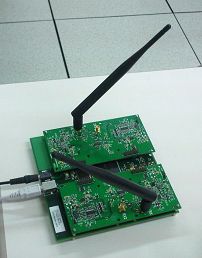
Gradiant’s approach is mainly oriented to security applications, and if follows two lines, associated to recent technologies that are not present in current market solutions.
On one hand, software defined radio (SDR). This refers to equipment that can perform diverse functionalities on the same hardware, since the bulk of the implementation is replaceable software. The next picture shows SDR equipment we have used to successfully implement a GSM jammer.
On the other, cognitive radio. This corresponds to systems that optimize radio transmission according to the state of the spectrum in their location. For example, they can detect “holes” and transmit in them, thus free of interference. Regarding this article, we are mainly interested in two of their capacities: spectrum analysis and information exchange with similar systems. A jammer can be much more effective if it concentrates all its energy in the bands with activity and adapts itself to the nature of that activity (interfering with WiFi or GSM is not the same, form example). Information exchange allows to extend perception without extending coverage.
The possibility to analyze existing transmissions can also be employed from a totally different goal, yet very interesting for the safety field: detecting jammers installed by felons (just another type of transmitters, with a characteristic signal).
By applying all this knowledge, Gradiant, in collaboration with University of Vigo, Spain, seeks to develop new jamming systems for safety applications, more efficient and, at the same time, respectful with the rights of citizens outside their perimeter.


